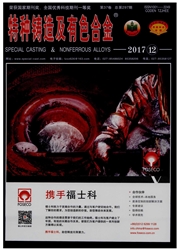

 中文摘要:
中文摘要:
退火的效果温度(与在 1 h 是不变的退火的时间)在微观结构上,订,剩余应力,机械性质,和有圆柱的谷物的 Fe-6.5wt%Si 电的钢的随后的冷滚动可使用性被调查,钢在哪儿是温暖的,在 500 正猠牵慦散?湡?牣捡?牧睯桴瀠瑡獨眠牥?湡污穹摥琠?汣牡晩?桴?滚动了??敭档湡獩獭鮐? 鮐 吗??
 英文摘要:
英文摘要:
The effects of annealing temperature(with the annealing time being constant at 1 h) on the microstructure, ordering, residual stress, mechanical properties, and subsequent cold rolling workability of Fe-6.5wt%Si electrical steel with columnar grains were investigated, where the steel was warm rolled at 500℃ with a reduction of 95%. The results show that recrystallization began to occur in the sample annealed at 575℃ and that full recrystallization occurred in the sample annealed at 625℃. When the annealing temperature was 500℃ or greater, the extent of reordering in the sample was high, which reduced the room-temperature plasticity. However, annealing at temperatures below 300℃ did not significantly reduce the residual tensile stress on the edge of the warm rolled samples. Considering the comprehensive effects of annealing temperature on the recrystallization, reordering, residual stress, and mechanical properties of the warm rolled Fe-6.5wt%Si electrical steel with columnar grains, the appropriate annealing temperature range is 300℃-400℃. Unlike the serious edge cracks that appeared in the sample after direct cold rolling, the annealed samples could be cold rolled to a total reduction of more than 71.4% without the formation of obvious edge cracks, and bright-surface Fe-6.5wt%Si electrical steel strips with a thickness less than 0.1 mm could be fabricated by cold rolling.
 同期刊论文项目
同期刊论文项目
 同项目期刊论文
同项目期刊论文
 期刊信息
期刊信息
